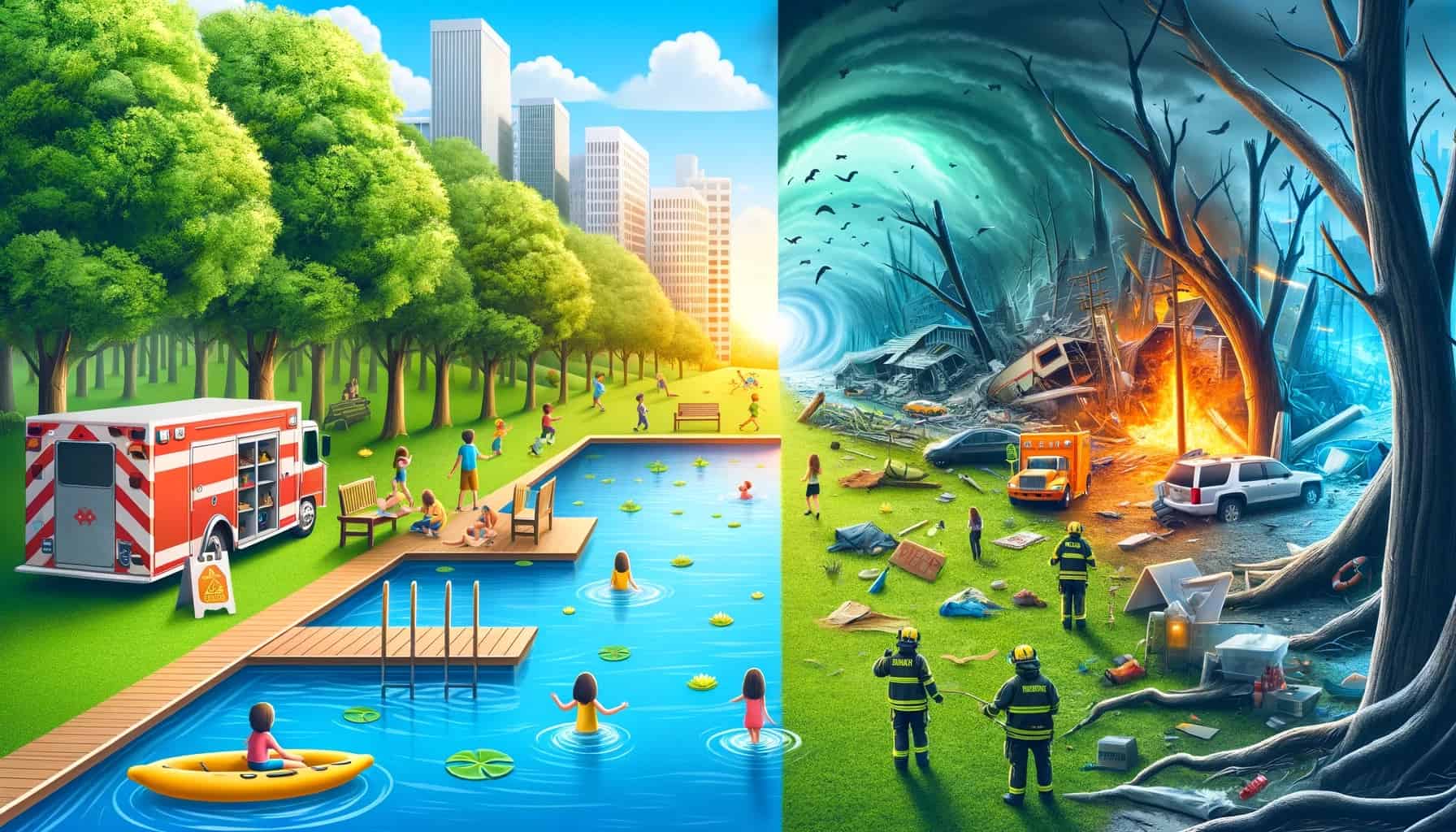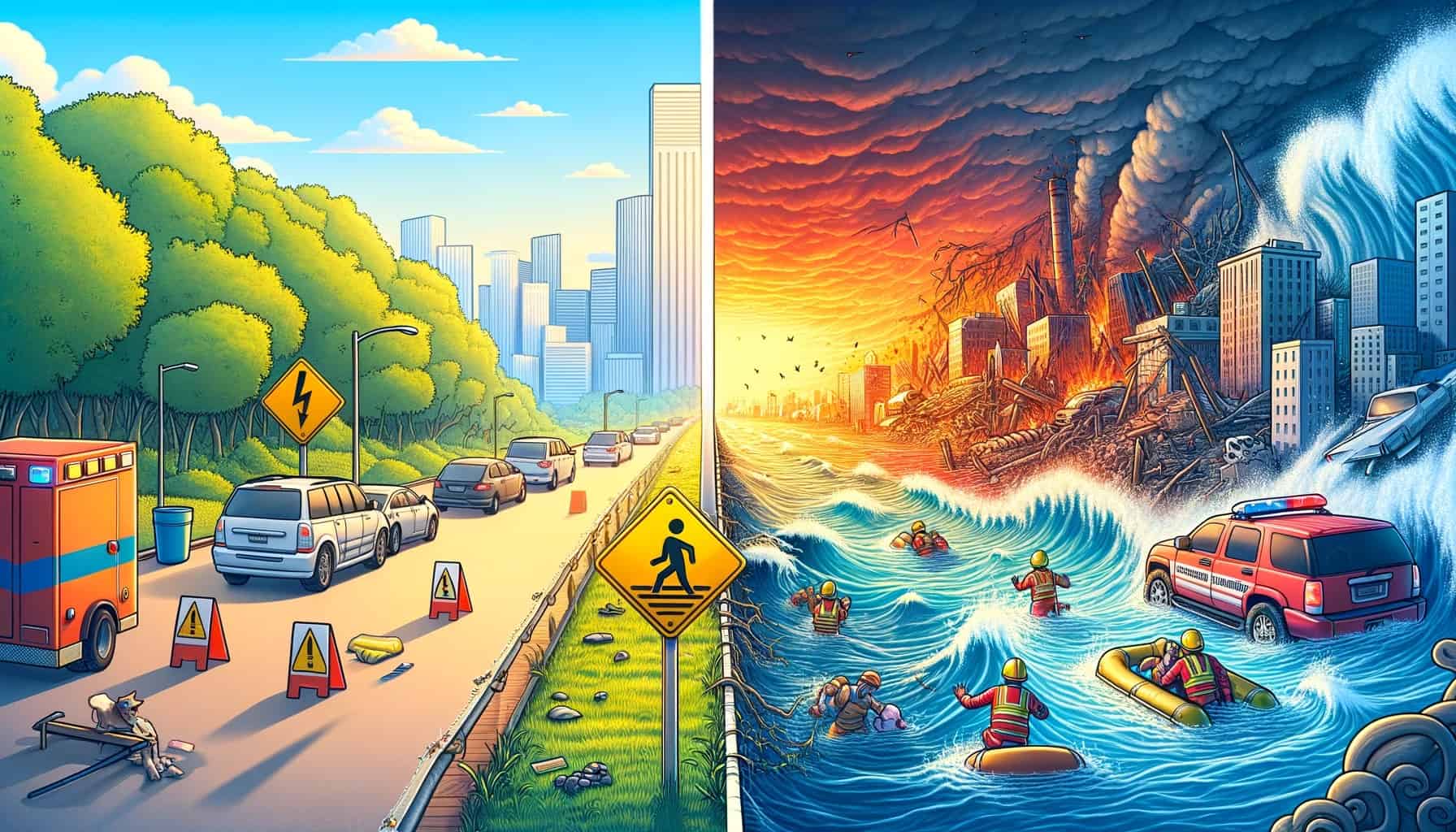Difference between hazard and disaster
by Yogi P - November 3, 2023
Difference between hazard and disaster | Understanding the Rift of Hazard vs. Disaster
When delving into the field of emergency management and risk assessment, one will encounter two pivotal terms: “hazard” and “disaster.” These terms, though often used synonymously by those outside the profession, have distinct meanings and implications for how societies prepare for and respond to emergencies.
Recognizing the difference between a hazard and a disaster is fundamental to implementing effective risk mitigation strategies and resilience planning.
Defining the Terms: Hazard
A hazard is a potential source of harm or adverse health effect on a person or persons. In the broader context, it refers to any phenomenon, environmental condition, or human activity that has the potential to cause disruption or damage to life, property, livelihoods, and the environment.
Key Characteristics of Hazards:
- Potential for Damage: Hazards carry the potential to cause damage but haven’t caused any yet.
- Types of Hazards: There are natural hazards (like earthquakes and floods), technological hazards (such as chemical spills and nuclear accidents), and human hazards (including war and terrorism).
- Predictability: Some hazards can be predicted with a degree of accuracy (like hurricanes), while others cannot (like earthquakes).
- Magnitude and Frequency: Hazards are characterized by their potential magnitude and frequency of occurrence.
Delving into the Details: Disaster
A disaster, on the other hand, is the realization of this potential: it occurs when a hazard impacts on the vulnerable population, causing significant damage, destruction, and disruption to community life that exceeds the community’s ability to cope using its own resources.
Key Characteristics of Disasters:
- Actual Occurrence: A disaster is the actual event of a hazard causing widespread destruction.
- Impact on Society: Disasters have significant human, material, economic, or environmental impacts.
- Response and Recovery: They often require emergency response to provide immediate relief and long-term recovery operations.
- Measuring Scale: Disasters can be categorized by scale and intensity, often using established metrics like the Richter scale for earthquakes.
The Intersection and Interaction
While a hazard represents a potential threat, a disaster is the consequence of a hazard occurring and causing impact. Not all hazards lead to disasters; the key factor that turns a hazard into a disaster is its impact on a vulnerable population.
Real-World Applications
Understanding the distinction is critical for governments, organizations, and individuals when preparing for potential threats:
In Hazard Assessment:
- Identification and analysis of potential hazards to determine risks.
- Developing early warning systems and preparedness plans.
In Disaster Management:
- Implementing emergency response and relief operations.
- Coordinating long-term rehabilitation and reconstruction efforts.
Analyzing Components
Preparedness and mitigation measures are distinct for hazards and disasters:
Hazard Components:
- Risk assessments to evaluate and prioritize potential hazards.
- Prevention and mitigation strategies to reduce the potential impact.
Disaster Components:
- Emergency operations plans to respond effectively to disasters.
- Recovery and rebuilding strategies post-disaster.

Hazard vs disaster
Overview Table: Difference between Hazard and Disaster
| Aspect | Hazard | Disaster |
|---|---|---|
| Definition | A potential threat that could cause harm. | An event that occurs when a hazard impacts society. |
| Nature | Possible, not yet occurred. | Real, significant impact has occurred. |
| Scope | Concerns the source of potential harm. | Involves the response to and impact of an event. |
| Preparation | Risk assessment, mitigation planning. | Emergency response, recovery planning. |
| Types | Natural, technological, human. | Small-scale, large-scale, complex emergencies. |
| Implications | Calls for readiness and preventative measures. | Demands immediate action and long-term solutions. |
| Management | Managed through preparedness and prevention. | Managed through coordinated response and recovery. |
| Examples | An inactive volcano, a manufactured chemical. | An erupting volcano, a chemical plant explosion. |
| Focus in Planning | Identifying and reducing risks. | Managing and recovering from impacts. |
| Community Role | Community awareness and preparedness activities. | Community resilience and post-disaster rebuilding. |
The Environmental and Societal Implications
The interface between hazards and disasters is where environmental conditions and societal vulnerabilities meet. Hazards become disasters due to the interplay of a community’s preparedness, response capabilities, and the environmental severity of the event.
Mitigation and Preparedness
Effective mitigation and preparedness strategies can prevent a hazard from escalating into a disaster. For example, stringent building codes in earthquake-prone areas (hazard mitigation) and community disaster preparedness drills can save lives and reduce damage when a hazard materializes into a disaster.
Economic and Human Cost
The economic and human cost of disasters can be colossal, underscoring the importance of investing in hazard identification and risk reduction strategies.
The Future: Building Resilience
As climate change and urbanization increase the complexity of hazards, building resilience against disasters has become a priority for sustainable development. Future strategies will likely focus more on integrating hazard mitigation in every aspect of urban planning and development.
Conclusion
The interplay between hazard and disaster is a dance between potential and reality. While hazards pose a threat, disasters are the manifestation of that threat wreaking havoc. Understanding their differences is crucial for effective risk management and emergency preparedness.
Recognizing a hazard and taking steps to mitigate its potential harm can prevent a disaster, highlighting the power of proactive intervention and the importance of resilience in the face of inevitable natural and man-made challenges.
Whether it’s a dormant volcano or a brewing storm, the key to transformation from vulnerability to strength lies in the preparedness of communities and the robustness of systems in place to manage these events. The ultimate goal is not just to survive disasters but to adapt and thrive in a world where hazards are a part of the landscape.










